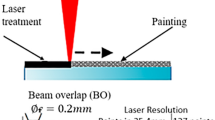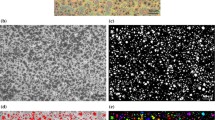Abstract
This paper presents the study on changes in element and phase compositions in the near-surface layer and on surface topography of the NiTi specimens after the silicon ion-beam treatment. The effect of these parameters of the near-surface layer on corrosion properties in biochemical solutions and biocompatibility with mesenchymal stem cells of rat marrow is studied. Ion-beam surface modification of the specimens was performed by a DIANA-3 implanter (Tomsk, Russia), using single-ion-beam pulses under oil-free pumping and high vacuum (10−4 Pa) conditions in a high-dose ion implantation regime. The fluence made 2 × 1017 cm−2, at an average accelerating voltage of 60 kV, and pulse repetition frequency of 50 Hz. The silicon ion-beam treatment of specimen surfaces is shown to bring about a nearly twofold improvement in the corrosion resistance of the material to attack by aqueous solutions of NaCl (artificial body fluid) and human plasma and a drastic decrease in the nickel concentration after immersion of the specimens into the solutions for ~3400 and ~6000 h, respectively (for the artificial plasma solution, a nearly 20-fold decrease in the Ni concentration is observed). It is shown that improvement of NiTi corrosion resistance after treatment by Si ions occurs mainly due to the formation of two-layer composite coating based on Ti oxides (outer layer) on the NiTi surface and adjacent inner layer of oxides, carbides, and silicides of the NiTi alloy components. Inner layer with high silicon concentration serves as a barrier layer preventing nickel penetration into biomedium. This, in our opinion, is the main reason why the NiTi alloy exhibits no cytotoxic properties after ion modification of its surface and leads to the biocompatibility improvement at the cellular level, respectively.










Similar content being viewed by others
References
M. Salmerón-Sánchez and G. Altankov, Cell-Protein-Material Interaction in Tissue Engineering, Advances in Regenerative Medicine: Role of Nanotechnology and Engineering Principles, V.P. Shastri, G. Altankov, and A. Lendlein, Ed., Springer, Dordrecht, 2010, p 3–15
G. Altankov, T. Groth, E. Engel et al., Development of Provisional Extracellular Matrix on Biomaterials Interface: Lessons from In Vitro Cell Culture, Advances in Regenerative Medicine: Role of Nanotechnology and Engineering Principles, V.P. Shastri, G. Altankov, A. Lendlein, Ed., Springer, Dordrecht, 2010, p 19–41
G. Mani, M.D. Feldman, D. Patel, and C.M. Agrawal, Coronary Stents: A Materials Perspective, Biomaterials, 2007, 28(9), p 1689–1710
A. Mahapatro, D.M. Johnson, D.N. Patel et al., Surface Modification of Functional Self-Assembled Monolayers on 316L Stainless Steel Via Lipase Catalysis, Langmuir, 2006, 22(3), p 901–905
O.N. Lazarenko, Influence of Coatings on the Stent Thrombosis and Restenosis, Praktikal Angiologiya, 2007, 7(2), p 42–49 [in Russian]
I.I. Kornilov, O.K. Belousov, and E.V. Kachur, Titanium Nickelide and Other Alloys with the Shape Memory Effect, Nauka, Moscow, 1977 [in Russian]
A.I. Lotkov, V.N. Khachin, V.N. Grishkov et al., Alloys with the Shape Memory Effect, Phys. Mesomech. Comput. Aided Des. Mater., 1995, 2, p 202–213 [in Russian]
V.N. Zhuravlev and V.G. Pushin, Alloys with Thermomechanical Memory and Their Application in Medicine, The Urals Branch of the Russian Academy of Sciences, Ekaterinburg, 2000 [in Russian]
D. Stoeckel, A. Pelton, and T. Duerig, Self-Expanding Nitinol Stents: Material and Design Considerations, Eur. Radiol., 2004, 2(14), p 292–301
L.L. Meisner, Mechanical and Physico-chemical Properties of Alloys Based on NiTi Thin Surface Layers Modified by Streams of Charged Particles, Fiz. Mesomekh., 2004, 7(2), p 169–172 [in Russian]
A.I. Lotkov, L.L. Meisner, and V.N. Grishkov, Alloys Based on NiTi: Ion-Beam, Plasma and Chemical Surface Modification, Fiz. Met. Metalloved., 2005, 99(2), p 1–13 [in Russian]
L.L. Meisner, A.I. Lotkov, V.A. Matveeva et al., Effect of Silicon, Titanium, Zirconium Ion Implantation on NiTi Biocompatibility, Adv. Mater. Sci. Eng., 2012, 2012, p 1–16
L.L. Meisner, V.A. Matveeva, A.I. Lotkov et al., Effect of Ion Alloying Silicon, Titanium, Zirconium Surface Layers of NiTi on the Cytotoxicity and Proliferation of Mesenchymal Stem Cells, Izv. Vysshikh Uchebn. Zaved. Fizika, 2011, 54(9), p 39–51 [in Russian]
Z. Jiang, X. Dai, and H. Middleton, Effect of Silicon on Corrosion Resistance of Ti-Si Alloys, Mater. Sci. Eng. B, 2011, 176(1), p 79–86
B. Kaur, K. Singh, and O.P. Pandey, Corrosion Study of SiO2-CaO-Al2O3-Na2O-TiO2 Glass Coating on Steel, Surf. Eng., 2013, 29(6), p 479–483
H. Shi et al., Characterization of Protective Performance of Epoxy Reinforced with Nanometer-Sized TiO2 and SiO2, Prog. Org. Coat., 2008, 62(4), p 359–368
J. Liu et al., Improved Corrosion Resistance of NiTi Alloy by Coated with TiO2-SiO2-HAP Composite Films, Adv. Mater. Res., 2013, 634, p 996–1000
K. Liu and L. Jiang, Metallic Surfaces with Special Wettability, Nanoscale, 2011, 3(3), p 825–838
L.K. Adams, D.Y. Lyon, and P.J.J. Alvarez, Comparative Eco-toxicity of Nanoscale TiO2, SiO2, and ZnO Water Suspensions, Water Res., 2006, 40(19), p 3527–3532
C.Y. Zheng et al., Enhanced Corrosion Resistance and Cellular Behavior of Ultrafine-Grained Biomedical NiTi Alloy with a Novel SrO-SiO2-TiO2 sol-gel Coating, Appl. Surf. Sci., 2011, 257(13), p 5913–5918
E.V. Vladimirskaya, O.A. Mayorova, S.A. Rumyantsev, and A.G. Rumyantsev, Biological Fundamentals and Prospects of Stem Cell Therapy, Medpraktika, Moscow, 2005, p 74–102 [in Russian]
F.M. Shemyakin, A.N. Karpov, and A.N. Brusen, Analytical Chemistry, Vysshaya Shkola, Moscow, 1965 [in Russian]
GOST-R ISO 10993-15-2009 Medical devices. Biological Evaluation of Medical Devices. Part 15. Identification and Quantification of Degradation Products from Metals and Alloys—M., Standartinform, 2010, p. 16.
A. Felmy, D. Girvin, and E. Jenne, MINTEQ: A Computer Program for Calculating Aqueous Geochemical Equilibria, US Environmental Protection Agency, Washington, DC, 1984, p 98
V.P. Shakhov, I.A. Khlusov, G.Ts. Dambaev et al., Introduction to Methods of Cell Culture and Organ and Tissue Bioengineering, STT, Tomsk, 2004, p 340–349 [in Russian]
T. Mosmann, Rapid Colorimetric Assay for Cellular Growth and Survival: Application to Proliferation and Cytotoxicity Assays, J. Immunol. Methods, 1983, 65, p 55–63
N.A. Plokhinskii, Biometry, MGU Press, Moscow, 1970 [in Russian]
B.D. Ratner and A.S. Hoffman, Physicochemical Surface Modification of Materials Used in Medicine, Biomaterials Science: an Introduction to Materials in Medicine, 2nd ed., B.D. Ratner et al., Ed., Elsevier Academic Press, London, UK, 2004, p 201–218
A.G. Akimov, On the Laws of Formation of Protective Oxide Layers in the Systems of Metal (Alloy)—Environment, Zashchita Met., 1986, 22(6), p 879–886 [in Russian]
T.N. Ustinskaya, N.D. Tomashov, and E.N. Lubnik, The Composition and Electrochemical Properties of the Protective Anode Film on the Intermetallic NiTi, Elektrokhimiya, 1987, 23, p 254–259 [in Russian]
L.L. Meisner, V.P. Sivokha, A.I. Lotkov, and E.G. Barmina, Corrosion Properties of Quasi-binary Alloys Cut TiNi-TiAu in Biochemical Solutions, Fiz. Khim. Obrab. Mater., 2006, 1, p 78–84 [in Russian]
S.A. Shabalovskaya, T. He, J.W. Andregg et al., The Influence of Surface Oxides on the Distribution and Release of Nickel from Nitinol Wires, Biomaterials, 2009, 30(4), p 468–477
S.A. Firstov, S.V. Tkachenko, and N.N. Kuzmenko, Titanium “Irons” and Titanium “Steel”, Metalloved. Termich. Obrab. Met., 2009, 1, p 14–20 [in Russian]
J.L. Murray, The Si-Ti (Silicon-Titanium) System, Phase Diagrams of Binary Titanium Alloys, J.L. Murray, Ed., ASM, Materials Park, 1987, p 289–293
F.F. Komarov, Ion Implantation into Metals, Metallurgiya, Moscow, 1990 [in Russian]
R. Goyer, Toxic Effect of Metals, Cassarett and Doull’s Toxicology, C. Klassen, M. Amdun, and J. Doul, Ed., McGraw-Hill, New York, 1986, p 582–635
A.L. Yarosh, A.A. Dolzhikov, A.V. Soloshenko et al., Study of Biocompatibility of Surgical Implants for a New Generation of Plastics Anterior Abdominal Wall, Med. Nauki, 2011, 10, p 186–189 [in Russian]
J.H. Kim, J.H. Shin, D.H. Shin et al., Comparison of Diamond-Like Carbon-Coated Nitinol Stents With or Without Polyethylene Glycol Grafting and Uncoated Nitinol Stents in a Canine Iliac Artery Model, Br. J. Radiol., 2011, 999(84), p 210–215
Acknowledgments
The financial support of the Siberian Branch of the Russian Academy of Sciences (Project No. III.20.3.1). The authors would like to thank Ph.D. A.V. Korshunov for carrying out and analyzing electrochemical tests.
Author information
Authors and Affiliations
Corresponding author
Rights and permissions
About this article
Cite this article
Psakhie, S.G., Meisner, S.N., Lotkov, A.I. et al. Effect of Surface Alloying by Silicon on the Corrosion Resistance and Biocompatibility of the Binary NiTi. J. of Materi Eng and Perform 23, 2620–2629 (2014). https://doi.org/10.1007/s11665-014-1112-7
Received:
Revised:
Published:
Issue Date:
DOI: https://doi.org/10.1007/s11665-014-1112-7




